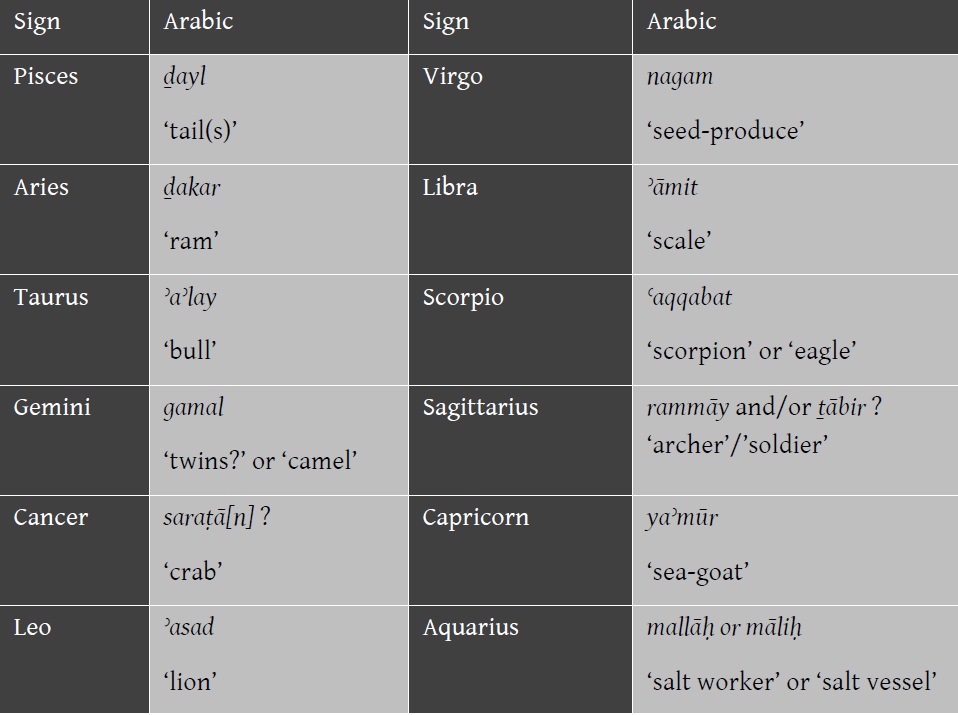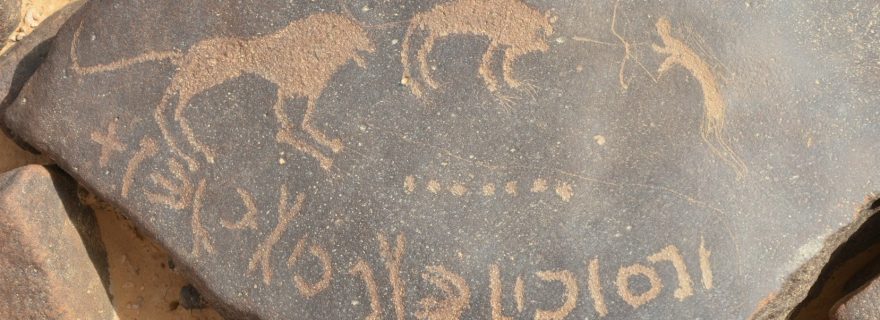An ancient zodiac from Arabia discovered
New discovery fuels debate on the links between Arabic-Islamic and pre-Islamic civilizations.
Cover photo: Safaitic inscription from the Jabal Qurma depicting a hunting scene (see also the website of the Jebel Qurma Project).
Beginning just south of Damascus and stretching as far as the sand dunes of the Nefud is a basalt wasteland known as the Harrah. The area is mostly unpopulated today, but two thousand years ago nomads roamed this region, seeking pasture and water. The most remarkable witness to lives of its ancient population is the tens of thousands of inscriptions adorning the desert’s rocks. These texts are written in an indigenous Arabian alphabet known as Safaitic and express a form of Old Arabic, perhaps as different from Classical Arabic, the language of Islamic civilization, as Beowulf’s English is from Chaucer's.
The Safaitic inscriptions are notoriously difficult to understand, and many of them contain re-occurring sets of enigmatic words which defy interpretation. Since the discovery of these inscriptions over a century ago, scholars have always assumed that these mysterious terms were the names of places. By considering not only their etymologies, but the way they pattern with the seasons and other chronological information, I have recently shown that they are in fact the names of the ecliptic constellations, the zodiac, and were used to reckon time.
The zodiac of Islamic times used names of the signs that were clear translations from Aramaic or Greek. The ancient Arabian zodiac, on the other hand, has much older roots, going back to Babylon. Almost all knowledge of this ancient tradition seems to have been lost by the Classical Islamic period. Al-Ṣūfī, the 10th century Persian astronomer, claimed that the zodiac was unknown to the pre-Islamic Arabs. Its discovery in the Safaitic inscriptions not only proves the opposite, but also suggests much closer cultural ties between the pre-Islamic nomads of Arabia and the great civilizations of the Fertile Crescent than has usually been assumed.

The Arabian Zodiac

Possible mythological representations of asterisms in the rock art (image from Jebel Qurma Project website).
The Arabian zodiac corresponds neither to the Greek/Aramaic nor Babylonian systems perfectly, but seems instead to sit somewhere in between the two. The names of three of the constellations, Pisces, Taurus, and Capricorn, side more closely with the Mesopotamian signs. In Greek and Aramaic, Pisces is represented by a Fish, while the Safaitic ḏayl (‘tail’) corresponds to the Babylonian name zibbātu (‘the tails’). The Babylonians called Taurus alû (‘the bull of heaven’), and Safaitic ʾaʾlay seems to be derived from the same source. The Arabian term for Capricorn, yaʾmūr, has several meanings in the Classical Arabic dictionaries – a wild beast; a beast resembling a goat, having a single branching horn in the middle of its head; a certain beast of the sea. Combining these together, the image of the Babylonian sign, a goat-fish hybrid, takes shape.
Most of the other constellations correspond in meaning with the Aramaic/Greek signs, but their names still differ from those found in the Classical Arabic tradition. Some signs are reimagined. Aquarius is a salt worker or vessel instead of a water bearer. Gemini is called gamal, which probably reflects a re-interpretation of the constellation as a Camel.
The name for Scorpio, ʿaqqabat, is open to two interpretations. While it is most likely derived from the normal Semitic word for scorpion, ʿaqrabat, a more adventurous interpretation is possible: the term could be related to Arabic ʿuqāb (‘an eagle’). The astrological connection between Scorpio and the eagle is well known in Christian times, but no clear evidence for this association has yet been discovered in the ancient sources. Some scholars have suggested that Scorpio was represented by an eagle in a few verses in the New Testament and the Hebrew Bible. In Revelation 4:7, John encounters four creatures:
“And the first beast was like a lion, and the second beast like a calf, and the third beast had a face as a man, and the fourth beast was like a flying eagle”
This statement echoes the famous vision of Ezekiel (1:10) of four Cherubim:
“Each had a human face in the front, the face of a lion on the right side, the face of an ox on the left side, and the face of an eagle at the back.”
Some Rabbinic scholars have interpreted Ezekiel’s vision as references to the zodiac signs, the lion = Leo, the ox = Taurus, the man = Aquarius, and the eagle = Scorpio. If this is correct and if the Safaitic term should in fact be translated as ‘eagle’, then the Arabian zodiac may provide the first clear evidence for the representation of this constellation by an eagle in ancient times. This could also imply that the Arabian zodiac stems from the same source – now lost – as the zodiac known to biblical authors.
The full historical implications of this finding are not yet clear, and many questions remain open. Did the Arabs borrow the zodiac from the Babylonians during their expansion into Arabia or does it represent a much older, shared cultural tradition? Can its intermediate status between the Babylonian and Greek names of the signs shed light on the dissemination of the zodiac across the Near East and eastern Mediterranean? Why did almost all knowledge of this particular zodiac disappear in the Islamic period? No matter how these questions are answered, its discovery underlines one inescapable fact: the image of pre-Islamic Arabia as presented in the literary sources of the Abbasid era is incomplete. Arabia’s pre-Islamic cultural, religious, and linguistic history is just beginning to be written, and the epigraphic record is essential.
To read more, see the original publication, Al-Jallad, A. 2014. ‘An ancient Arabian zodiac. The constellations in the Safaitic inscriptions, Part I’. Arabian Archaeology and Epigraphy 25.2: 214-230. For more of Al-Jallad’s publications, see here.



4 Comments
Another possibility for giving the Scorpio constellation the name "Aqqabat" ... Mat be because this word by exact meaning like it is pronounced (عقبات) in Arabic = (Obstacles)...
And we know the relation between Scorpio and obstacles very well plus... The via combusta is here with the most dangerous fixed stars.
it is interesting that these "four faces" (bird, bull, lion, man) are also found on the column capitals of Persepolis. Also some Islamic Hadith mention them as four of the "Carriers of the Throne of God".
@Clive Durdle. Thank you for your message. I don't think we can prove any Celtic connection. The full moon, it seems, plays a role in the Arabian 'calendar' as well. About seven inscriptions date to the period the 'full moon' (or cosmic setting) was in a specific constellation. Could this be the predecessor of a lunar calendar in which the full moon marks the beginning of a month? It's possible...but certainly unprovable at this stage.
Are there Celtic influences? http://www.roman-britain.org/celtic/coligny.htm